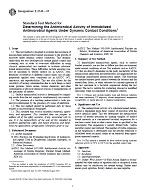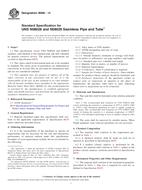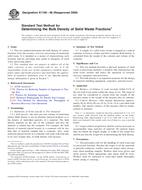1.1 This standard provides test methods for evaluating the structural capacity and integrity of end-joints in structural wood products.
1.2 End-joints are manufactured by adhesive bonding of machined, mated surfaces at the ends of two pieces of lumber to form a joint. Typical end-joint configurations include finger joints and scarf joints. The combination of one or more end-joints and the adjoining sections of the structural wood product within the assembly is considered to be the test specimen.
1.3 Off-line test methods include: (1) Axial Tension, (2) Bending, and (3) Cyclic Delamination.
1.4 In-line test methods include: (1) Tension Proofload and (2) Bending Proofload.
1.5 The values stated in inch-pound units are to be regarded as standard. The values given in parentheses are mathematical conversions to SI units that are provided for information only and are not considered standard.
1.6 This standard does not purport to address all of the safety concerns, if any, associated with its use. It is the responsibility of the user of this standard to establish appropriate safety and health practices and determine the applicability of regulatory limitations prior to use.
5.1 This test method provides procedures for the determination of the axial tensile capacity of full-size end-joint specimen off-line.
5.2 Applications of this test method include: end-joint qualification and daily quality control of production, and other purposes where the strength of a full-size end-joint must be verified or determined.
10.1 This test method provides off-line test procedures for the determination of the capacity of the end-joint in bending on short spans subjected to a 4-point loading.
10.2 Applications of this test method include: end-joint qualification and daily quality control, and other purposes where the strength of a full-size end-joint are to be verified or determined.
15.1 This test method provides procedures for assessing the ability of the bond to resist separation after repeated exposure to moisture and drying. This test method is for end-joints in products requiring evaluation of durability, and also provides an indication of the overall consistency of the end-joint manufacturing process.
Note 13 – This is adopted from Test Methods D 1101, Test Method B, for finger joints.
21.1 This test method provides an in-line quality assurance procedure for end-joint strength.
21.2 This method does not provide sufficient means to fully characterize the strength parameters of a population or sample of end-joints, and is not intended to be a substitute for off-line process qualification and on-going quality control testing.
21.3 This method reduces the variability of the lower end of strength distribution by culling low-strength end-joints.
Note 21 – Although this method improves the structural reliability, it does not necessarily provide absolute assurance those end-joints proofloaded to a specified test level will not fail when reloaded to the same tension stress level.
Note 22 – In a continuous end joining process, end-joints may occasionally appear in the grips. Provided this is a random occurrence, the application is still considered to meet the requirements of this method.
Product Details
- Published:
- 11/01/2008
- Number of Pages:
- 13
- File Size:
- 1 file , 160 KB


